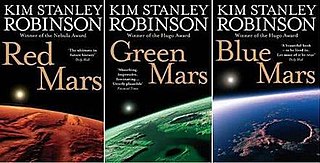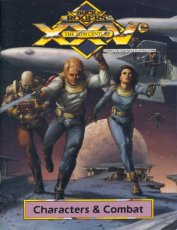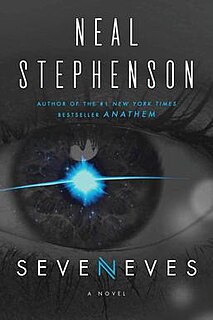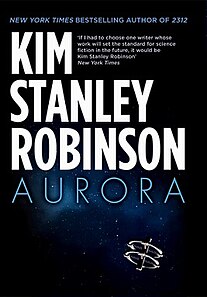Plot introduction
A couple of centuries from the present, artificial intelligences and nanotechnology are in widespread use in the Solar System and in some cases have caused disasters. Some people do not trust these technologies and plan a simpler life in a distant planetary system, where they plan to terraform a planet called Ymir. Once Ymir is habitable, they will abandon use of all advanced technology. Three sleeper ships leave the Solar System bound for Ymir, using suspended animation to keep the crew and settlers alive during the sub light-speed journey. While in transit, all communication with the Solar System ends; by implication, human civilisation has fallen. The lead ship, John Glenn, is crippled by a design flaw en route, and uses all its antimatter fuel to reach the nearest star system, Apollo. It warns the other two ships, which can correct the flaw, but there is no word from them about whether they reach Ymir.
The John Glenn creates a substantial moon around the gas giant Harlequin by colliding several smaller moons together, and give it an atmosphere, seas, and the beginnings of an ecosystem. This takes 60,000 years, with almost all the passengers of the ship in hibernation during the entire time. The person in charge of creating and terraforming the new moon, Selene, is Gabriel.
Apart from a brief prologue, the novel begins as the second generation of people born on Selene approach adulthood.
Plot summary
Gabriel is teaching a group of moon-born teenagers about agriculture. Rachel is one of these; she passes her exams and is selected by Gabriel to become a leader of the moon-born. Andrew is another; he fails his exams because he plays a practical joke on Rachel. Gabriel takes Rachel to the John Glenn. As the first moon-born to visit the ship, she arouses hostility from some of the leaders there. She learns that there are three classes amongst the space travelers: five are High Council, who rule until Ymir is reached; some dozens are Council, including Gabriel, and have extended privileges; and the remaining "Earth-born" are colonists, many of them not having been unfrozen since leaving Earth and with few rights. She also learns to use the vast repository of knowledge in the ship's library, and makes contact with the AI "Astronaut" who is kept severely restricted because the High Council doesn't trust high technology. Rachel comes to realise that when the moon-born have helped restock the ship with antimatter the John Glenn will continue on to Ymir without them, leaving them on a moon that can only sustain life for a century or two.
Gabriel decides there is no immediate need for him and Rachel to return to Selene, and that as a leader Rachel would be most useful with the longer lifespan that is conferred by the suspended animation process, and has himself and Rachel frozen for a year. Problems with radiation flares intervene, and without Gabriel to stand up for her, they are left frozen for twenty years. Rachel returns to Selene to find her best friend killed in an accident, her boyfriend married and with children almost her own age, and her remaining friends more than twice as old as she is. She also realizes that the moon-born are being treated as slaves, with Earth-born as overseers. The moon-born must develop the technological infrastructure to refine antimatter, but there are major risks involved in the refining which could destroy the population of Selene.
Rachel becomes a teacher of the next generation of moon-born. She teaches them what she is supposed to, but she also includes concepts from Earth history that she learns from the library and Astronaut - concepts such as democracy and passive resistance. She has a few friends among Council, and Astronaut is able to conceal her communications with them from other Council and High Council. Andrew (a childhood enemy) plays a more active role in stirring up rebellion, but the moon-born have no power to change their role. The Council notices the passive resistance and their members begin carrying weapons. Some years later, one of the ship's boats crash lands on Selene and is abandoned there. It has sufficient electronics to house an AI, and Rachel's Council friends make a copy of Astronaut there, Vassal, unknown to High Council.
Ten years after Rachel was unfrozen, an accident leads to a Council member shooting one of the moon-born. Andrew leads a revolt and takes a Council member hostage. The rebellion is halted by a flare which requires everyone to shelter together, and by Rachel's heroic intervention. In the wake of the rebellion, a new understanding is reached between the moon-born and the High Council. They will work more as equals, and the refinement of the antimatter will take place at a safe distance from Selene. The travellers will leave more technology behind when they leave (including the copy of Astronaut) so Selene can survive. This is at a cost of delaying their departure significantly. Gabriel decides he will remain on Selene when John Glenn departs.
A final, short, section of the novel sums up the next two hundred years, with the antimatter refined, the flare problem on Selene permanently dealt with, and John Glenn preparing for departure. Periods of suspended animation keep Rachel and Gabriel young.
There is room for a sequel, dealing with either or both of the futures of John Glenn and Ymir, and of Selene.

Interstellar travel refers to the idea of interstellar probes or crewed spacecraft moving between stars or planetary systems in a galaxy. Interstellar travel would be much more difficult than interplanetary spaceflight. Whereas the distances between the planets in the Solar System are less than 30 astronomical units (AU), the distances between stars are typically hundreds of thousands of AU, and usually expressed in light-years. Because of the vastness of those distances, non-generational interstellar travel based on known physics would need to occur at a high percentage of the speed of light; even so, travel times would be long, at least decades and perhaps millennia or longer.

Terraforming or terraformation ("Earth-shaping") is the hypothetical process of deliberately modifying the atmosphere, temperature, surface topography or ecology of a planet, moon, or other body to be similar to the environment of Earth to make it habitable for us humans to live on.

The Moon Is a Harsh Mistress is a 1966 science fiction novel by American writer Robert A. Heinlein about a lunar colony's revolt against absentee rule from Earth. The novel illustrates and discusses libertarian ideals. It is respected for its credible presentation of a comprehensively imagined future human society on both the Earth and the Moon.

The Mars trilogy is a series of science fiction novels by Kim Stanley Robinson that chronicles the settlement and terraforming of the planet Mars through the personal and detailed viewpoints of a wide variety of characters spanning almost two centuries. Ultimately more utopian than dystopian, the story focuses on egalitarian, sociological, and scientific advances made on Mars, while Earth suffers from overpopulation and ecological disaster.
Earthsearch: A Ten-Part Adventure Serial in Time and Space is a science fiction radio series written by James Follett. It consists of ten half-hour episodes. It was first broadcast on BBC Radio 4 between January and March 1981. There is also a novelisation by Follett of the same name. The series has been released on cassette and audio CD. Since 2003 it has been re-broadcast, several times in the Seventh Dimension science fiction slot on BBC 7 and its successor BBC Radio 4 Extra.

World at the End of Time is a 1990 hard science fiction novel by American writer Frederik Pohl. It tells the parallel stories of a human and a plasma-based intelligence who manage to survive to the time near the heat death of the universe. The book is thus a combined work in speculative cosmology and space colonization.

Buck Rogers XXVC is a game setting created by TSR, Inc. in the late 1980s. Products based on this setting include novels, graphic novels, a role-playing game (RPG), board game, and video games. The setting was active from 1988 until 1995.

Space is a novel by James A. Michener published in 1982. It is a fictionalized history of the United States space program, with a particular emphasis on human spaceflight.

Expendable is a science fiction novel by the Canadian author James Alan Gardner, published in 1997 by HarperCollins Publishers under its various imprints. It is the first book in a series involving the "League of Peoples", an assemblage of advanced species in the Milky Way galaxy. There is a "sub-series" involving just the character Festima Ramos, and sometimes the female Oar.
The Grand Tour is a series of novels written by American science fiction author Ben Bova.

The following outline is provided as an overview of and topical guide to space exploration.

The United States Spacecraft Discovery One is a fictional spaceship featured in the first two novels of the Space Odyssey series by Arthur C. Clarke and in the films 2001: A Space Odyssey (1968) directed by Stanley Kubrick and 2010: The Year We Make Contact (1984) directed by Peter Hyams. The ship is a nuclear-powered interplanetary spaceship, crewed by two men and controlled by the AI on-board computer HAL 9000. The ship is destroyed in the second novel and makes no further appearances.
"Matter of Life and Death" is the second episode of the first series of Space: 1999. The screenplay was written by Art Wallace and Johnny Byrne; the director was Charles Crichton. The original title was "Siren Planet". The final shooting script is dated 8 January 1974. Live-action filming took place Monday 14 January 1974 through Wednesday 30 January 1974.

The Silent Stars Go By is a hardback Doctor Who novel written by Dan Abnett for the BBC Books New Series Adventures line. The novel features the Eleventh Doctor, Amy Pond, and Rory Williams and sees the return of the Ice Warriors. The Silent Stars Go By was re-released in 2013, in paperback for the 50th Anniversary of Doctor Who, with a different front cover.

"Brake" is a science fiction short story by American writer Poul Anderson, first published in 1957 in Astounding Science Fiction and reprinted in the collections Beyond the Beyond (1969) and The Psychotechnic League (1981). As a component of the Psychotechnic League future history / alternate history, "Brake" takes place in 2270, as the civilization built up in the aftermath of the 1958 Third World War is being torn between mutually antagonistic factions, on the verge of collapsing into "the day of genocide and the night of ignorance and tyranny".

The Engines of God is a science fiction novel by American author Jack McDevitt.

Seveneves is a hard science fiction novel by Neal Stephenson published in 2015. The story tells of the desperate efforts to preserve Homo sapiens in the wake of apocalyptic events on Earth after the unexplained disintegration of the Moon and the remaking of human society as a space-based civilization after a severe genetic bottleneck.

Aurora is a 2015 novel by American science fiction author Kim Stanley Robinson. The novel concerns a generation ship built in the style of a Stanford torus traveling to Tau Ceti in order to begin a human colony. The novel's primary narrating voice is the starship's artificial intelligence. The novel was well-received by critics.
Martyn J. Fogg is a British physicist and geologist, an expert on terraforming.
This page is based on this
Wikipedia article Text is available under the
CC BY-SA 4.0 license; additional terms may apply.
Images, videos and audio are available under their respective licenses.














